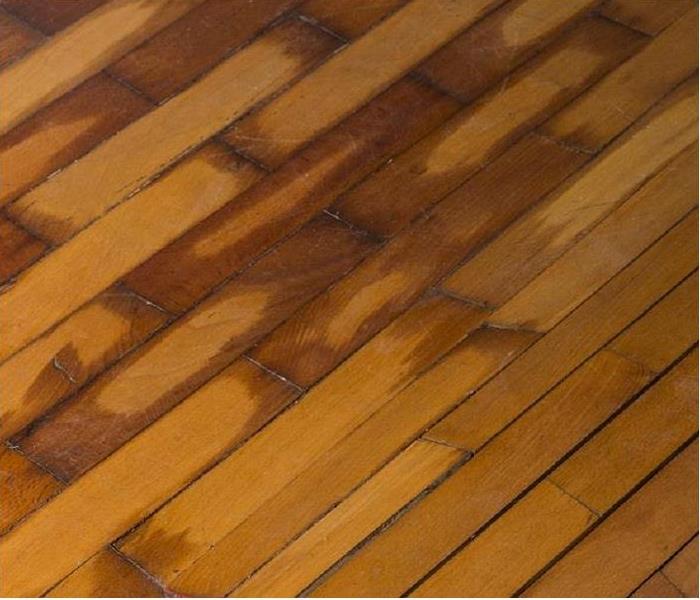Do Hardwood Floors in My Everett House Need to Be Torn Out and Replaced After Water Damage?
7/15/2020 (Permalink)
Open Patio Doors and an Overactive Sprinkler Put Your Beautiful Floors at Risk -- Trust SERVPRO to Take All the Steps Necessary to Save Water Damaged Hardwood in Everett
You were running errands while your automatic sprinkler system worked overtime and caused the hardwood floor in your Everett attached garden room to endure a sustained shower. Work with the vendor who sold you the sprinklers to re-time and position the spray but reach out to us to manage the water damage.
What Is the "Anatomy" of a Hardwood Floor?
The good news is that authentic hardwood floors are relatively durable, even when forced to endure water damage. Everett residents need to involve professional restorers when evaluating the degree of harm suffered by the materials. The state of the surface area tells only a small part of the story. Visible hardwood strips or planks are made of a dense variety of wood, necessary to stand up to foot traffic, and provide substantial water durability. A protective finish usually adds to the ability of hardwood to shed wet tracking and spills.
Hardwood typically installs over at least one subfloor layer composed of plywood or particleboard sheets. This underlayment is unfinished, and thus quickly absorbs moisture.
Why Does the Underlying Unfinished Layer Matter?
When we arrive to assess the water damage to your hardwood floor, we note the subfloor's condition. Engineers do not construct hardwood floors to be waterproof, just water-resistant, and there is no vapor barrier between the top boards and the subfloor. As the sprinkler spray spreads across the floor, a portion of the water percolates down to saturate the porous underlayer. This migration causes problems for more than the wet plywood or other material. The hardwood top layer usually is unfinished on the bottom and sides, much more susceptible to absorbing water wicked up from below.
What Kinds of Hardwood Floor Damage Can You Expect from Subfloor Saturation?
As the hardwood strips or planks take on water, the material's fibrous makeup leads to expansion as the cells swell. The expansion can result in:
- Cupping -- when water absorbed from the subfloor causes the edges of each strip or plank to raise as it expands, creating a concave surface along with the material that resembles a cup if seen in cross-section
- Buckling -- where the hardwood absorbs so much water that it raises at the edges and joints in a continuous strip or plank line, dislodging entire pieces from the floor
- Crowning -- usually a post-drying complication, occurring when the hardwood becomes overdried on the bottom, but the top of the strips or planks contain more water and thus bulge
How Do Professionals Remove Water from Hardwood Floors?
A rapid removal of the water on all hardwood levels and its underlayers can minimize the effects of the water damage in Everett, often avoiding the need for repairs or refinishing. When we talk about removing the water, it is essential to note that we never intend to lower the hardwood's moisture content below its average level. The "normal" level for your floor will vary slightly from that in another home, but it averages about 10 percent in the United States. When we scope out your hardwood water damage, careful testing with moisture detectors and meters reveals moisture content. Sampling the moisture levels of another hardwood floor in your home provides data permitting us to complete appropriate drying. To remove the liquid water and then dry wood in all the layers we:
- Use squeegees and wanded extractors to corral and suction the remaining surface water
- Install sealable floor mats on areas tested and found wet on several levels, and attach via hoses to negative air pressure generators to extract the fluids
- Consider removing one or more strips or planks to gain access to the subfloor and facilitate drying
- Consider removing the hardwood finish or pricking the surface with pinholes to encourage evaporation
- Position air movers, heaters, and dehumidifiers to complete drying to the appropriate moisture measurements
Can the Hardwood Be Restored if Warping of Some Kind Exists?
After the water and moisture removal completes waiting for a brief time to decide if reworking or refinishing is necessary is best practice. If the remediation efforts do not return the hardwood to its preloss condition, sanding and refinishing can bring about the desired results. Cupping responds well to sanding and refinishing. Buckling indicates more severe water damage that might require sections being removed and replaced. Crowning, which is usually the result of over-drying as explained above, is nearly impossible to sand out. Unfortunately, all or part of your floor could need replacement if crowning is widespread.
If your hardwood floors have taken an unscheduled shower, SERVPRO of North Everett / Lake Stevens / Monroe will consult and help with water and moisture removal. Call us at (360) 243-8313 for an evaluation of your circumstances.






 24/7 Emergency Service
24/7 Emergency Service
